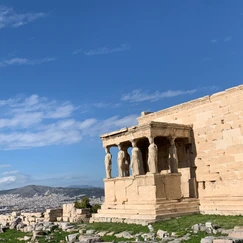Athens is a city waiting to be discovered: it embodies the spirit of an European capital (with busy streets, nightlife and different kinds of shops), but at the same time it contains more “authentic”, less populated areas, where you can breathe the heart of Greece and of the Hellenic culture. The extraordinary thing is that the culture of the country is breathed in every corner. Discover Athens by walking through its streets. Notice there is a continuous intersection between contemporary buildings/structures and the archaeological monuments, that always remind us the origins of the city. The major symbol is the Acropolis, which stands out on top of the hill and can be always admired by walking from different parts of the city.
Athens is a capital city that is always open to the future, but showcases its culture and heritage in every corner
So let’s see an itinerary and some of the unmissable neighborhoods for those who want to discover this city!
Discover Athens The neighbourhoods of Athens
Kolonaki
Between luxury shops, busy streets and a view of Syntagma square
Let’s start with the neighborhood where you can breathe the air of the capital and of the big city: Kolonaki. We are here in a wealthy and residential zone. It is elegant, ideal for shopping and nightlife (with restaurants, bars and clubs open until late). Kolonaki is positioned between the Lycabettus Hill and Syntagma Square. It takes its name from the 2 meter high column, ancient but still visible in the main square. It is an ideal area for strolling surrounded by the air of the capital: between luxury shops, busy and local streets, cafes or taverns.
To see in Kolonaki
Benaki Museum, Cycladic Art Museum, Byzantine Museum, Syntagma Square, Lycabettus, Athenian University and Library.
FOCUS
-Syntagma square: one of the most representative places in the city. Here you will find several metro lines, public transport, hotels, cafes and restaurants. It is also possible to see the Hellenic Parliament and to watch the changing of the guard at the stroke of every hour. The best time to visit? Sunday at 11 a.m., when there is a ceremony with the band’s presence and the presidential guard. Make sure to arrive well in advance, as the situation is often quite crowded!)
-Licabetto: rocky hill, which rises between the buildings of the city. It is the highest of the capital’s seven hills. The climb up the rock face is not so strenuous and can be easily done on foot (or, for the lazy one, by funicular!). The fact remains that the view from here is truly spectacular, especially at sunset. From the top opens a breathtaking view of the city, which can please tourists as well as locals.
-Modern Academy, Athenian library and University. The Academy that can be seen today was designed and completed in 1887 by Theofil Hansen. It is located between the neoclassical buildings that are the National Library and the University. All three buildings are in Panepistimiou street.

Plaka
The authenticity, between contemporaneity and history
Plaka is the historical district of the city and one of the most authentic and fascinating areas. Here you can find the heart of Athenian culture (such as the Acropolis Area and the surrounding monuments), as well as several typical family-run restaurants and small shops. It is possible, in fact, to enjoy a complete lunch with typical Greek dishes at reasonable prices, as well as go shopping in souvenir shops (but, in this case, be careful of tourist prices!)
In this area you can breathe the air of Greek history and origins. Touristy but less crowded, Plaka allows you to immerse yourself in the Athenian streets while fully admiring the majesty of its archaeological sites.
TO SEE
Acropolis (theater of Dionysus, Peripatos, theater of Herodes Atticus, temple of Athena – ancient statue of Athena, Erechtheum – or temple to Athena and Poseidon, where it is possible to admire the Caryatids as columns -, Parthenon), Museum of the Acropolis.
FOCUS
-Acropolis: known worldwide and a symbol of Athens, as well as of Greece itself, the Acropolis stands 156 meters above sea level. Its construction dates back to 448 BC, in 1987 it was declared a UNESCO World Heritage Site. To better appreciate the beauty of this site, understanding its origins and history in greater depth (including destruction, conquests and reconstructions), a visit to the Acropolis Museum, located in the surrounding area, is also recommended. In addition to the various artifacts that were discovered during archaeological excavations, on the top floor there is an interesting exhibition of sculptures and remains of the Parthenon. Excellent for understanding how it was originally built, before repeated destruction.
-Parthenon: it was built as a temple dedicated to the goddess Athena, protector of Athens. Its construction begins in 447 BC, but it took nine years to finish the main structure and six years to finish the decorations and other improvements.
-Erechtheion: originally dedicated to Athena and Poseidon, it is located north of the Acropolis. The structure was built between 421 and 406 BC. Spearhead: the six Caryatids (female statues) placed as the load-bearing structure of the roof.
-Temple of Athena Nike: built in honor of the goddesses Athena and Nike, it was built in 420 BC and it really resisted for a long time, until 1686 (the year in which it was destroyed by the Turks). It was later rebuilt (in 1834) and underwent several changes until the current restoration.

Monastiraki
Delve into the historical ruins and worldly places
A neighborhood near the Ancient Agora, where contemporaneity is well inserted among the ancient ruins. Meet Monastiraki.Hereyou will find a wide choice of shops, taverns, restaurants and night clubs. There a market that stretches along a street, starting from the main square. It is precisely from this square that the whole district develop . This place is a great starting point to visit other important historical spots. The Library of Hadrian (dating back to 132 AD is one of them. Or drink something in the evening with an impressive view of the Acropolis, from one of the panoramic-terrace bars.

Psyri
(antiquity) out of the ordinary
Particular and alternative: for this reason it takes the nickname of “Soho of Athens”. Psyri is one of the oldest areas of the capital, but less touristy than the other districts (despite being 10 minutes from Plaka). In this neighborhood there are important art galleries, shops and also ethnic restaurants. Here you will find the famous Central Market and you will be able to eat excellent Souvlaki, an authentic specialty of Greek cuisine!
TO SEE:
Central market.It is more difficult to find the classic souvenir shops: there is rather the possibility of encountering strange objects, coming from different parts of the world. There are as well different spices, perfumes and food (with different types of meat, fish and vegetables). This is excellent for those who want to enter in a typical area. Less crowded with tourists, which contains typical products but also multi-ethnic flavors. Open Monday to Saturday.

Discover Athens: Archaeological Sites
In addition to the Acropolis area, with the inclusive ticket of 30 euros, it is also great to visit other places. For example, the Library of Hadrian, the Ancient Agora, the Roman Agora, the archaeological site of Lykeion (Aristotle’s school), the museums of the Ancient Agora, and the Kerameikos cemetery. In the winter season, prices are reduced to 10 euros for the Acropolis . The entrance to the Acropolis museum, on the other hand, is 5 euros.

Discover Athens: Typical Dishes
Souvlaki, tzatziki sauce, moussaka, gyros pita, Greek salad, feta, Spanakopita (savory pie with spinach or feta), ouzo.

Discover Athens: Like a Local
To! Kafeneio (Epicharmou 1, Plaka)
Scholarchio (Tripodon 14, Plaka)
Tavern “Platanos” (4 Diogenous street, Plaka)
Luvnroll House (Karaiskaki 14, Psirri Ermou)
T.A.F. – The Art Foundation: Art Space/Bar/Boutique Store (Normanou 5, Monastiraki)

Athens: a really special city to visit. Especially if you love long suggestive walks (in fact, despite being a big city, it is very easy to walk and to move freely between the different neighborhoods). Last tip: remember to respect the “real owners” of the city, who rule and move freely among the archaeological sites and monuments: the cats!




















Discussion about this post